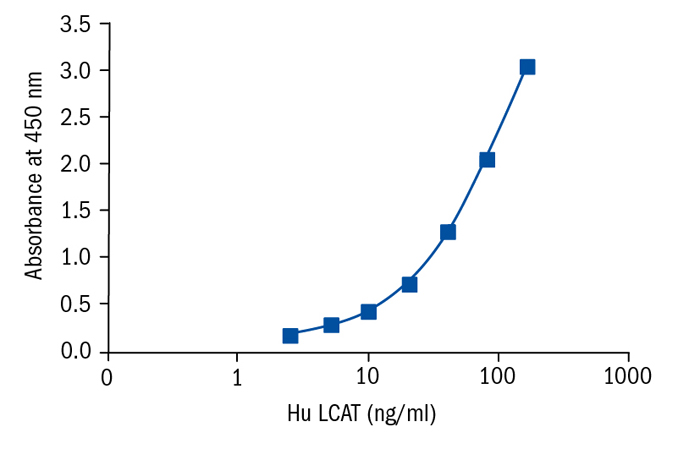Type
Sandwich ELISA, Biotin-labelled antibody
Applications
Serum, Plasma-EDTA, Plasma-Citrate, Cerebrospinal fluid
Sample Requirements
serum and plasma: 5µl/well
CSF: 10µl/well
Shipping
At ambient temperature. Upon receipt, store the product at the temperature recommended below.
Storage/Expiration
Store the complete kit at 2–8°C. Under these conditions, the kit is stable until the expiration date (see label on the box).
Calibration Curve
Calibration Range
2.5–160 ng/ml
Limit of Detection
0.27 ng/ml
Intra-assay (Within-Run)
n = 8; CV = 2.6%
Inter-assay (Run-to-Run)
n = 6; CV = 5.9%
Spiking Recovery
97,40%
Dilution Linearity
102,80%
Crossreactivity
- bovine Non-detectable
- cat Non-detectable
- dog Non-detectable
- goat Non-detectable
- hamster Non-detectable
- horse Non-detectable
- human Non-detectable
- chicken Non-detectable
- pig Non-detectable
- rabbit Non-detectable
- rat Non-detectable
- sheep Non-detectable
- monkey Yes
- mouse Yes
Features
- It is intended for research use only
- The total assay time is less than 3.5 hours
- The kit measures LCAT in serum, plasma (EDTA, citrate) and cerebrospinal fluid (CSF)
- Assay format is 96 wells
- Standard is recombinant protein based
- Quality Controls are human serum based
- Components of the kit are provided ready to use, concentrated or lyophilized
Research topic
Cardiovascular disease, Lipoprotein metabolism
Summary
Human Lecithin: cholesterol acyltransferase (LCAT) is a glycoprotein with a molecular mass of approximately 58 kDa. It is the key enzyme responsible for esterification of free cholesterol to cholesteryl esters in circulating plasma lipoproteins, primarily in high density lipoprotein (HDL). The tertiary structure of LCAT is maintained by two disulfide bridges, similar to lipases and other proteins of the α/β hydrolase fold family. Mature LCAT protein is synthesized from a 440 residue precursor by following cleavage of a 24 residue signal peptide. The mature protein contains 416 amino acids and is heavily N-glycosylated. LCAT is abundant in blood plasma and it is present in other organs, including liver, brain and testes. In plasma LCAT is associated with ApoD which frequently co-purify. A recent study suggests that LCAT can act as an antioxidant and prevent the accumulation of oxidized lipid in plasma lipoproteins. LCAT performs a central role in HDL metabolism by catalyzing the formation of cholesteryl esters on HDL through the transfer of fatty acids from the sn-2 positions of phosphatidylcholine (PC) to cholesterol. The role of LCAT in atherosclerosis is unclear. Dullaart et al. showed that plasma LCAT activity is elevated in metabolic syndrome and may be a marker of subclinical atherosclerosis. Sethi et al. demonstrated that low lecithin-cholesterol acyltransferase (LCAT) activities and high pre-ß1-HDL concentrations are strong positive risk markers for ischemic heart disease and are independent of HDLcholesterol. Miida et al. demonstrated that plasma pre β1-HDL concentration increase in subjects with low LCAT activity. They also reported that patients with coronary artery diseae (CAD) had higher pre-ß1-HDL concentrations than did normolipidemic subjects. Holleboom et al. showed that low plasma LCAT levels (reflecting low LCAT activity) are not associated with an increased risk of future (CAD) in the general population. However, other studies showed a positive association of LCAT levels with carotid atherosclerosis in patients with the metabolic syndrome as well as in control subjects whereas, LCAT activity was reduced in patients with CAD and in patients with acute myocardial infarction. In summary, LCAT activity might be reduced in the acute phase of a myocardial infarction. Mutations of LCAT on chromozome 16 resulting in homozygous or compound heterozygous form can cause two major phenotypes: FLD (familial LCAT deficiency) and FED ( Fish Eye Disease). Patients with FLD have a complete loss of both α-LCAT activity and β-LCAT activity and an increased proportion of unesterified cholesterol in plasma. In FED is partial loss of α-LCAT activity with normal elevated free cholesterol in plasma. Both FLD and FED are characterized by the development of corneal opacities.
Find documents for the lot
Example Instructions for Use (RUO)
Example Instructions for Use (RUO)
Safety Information (RUO)
MSDS (RUO)
MSDS (RUO)

